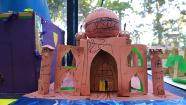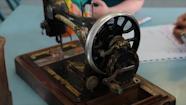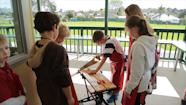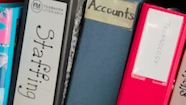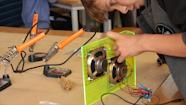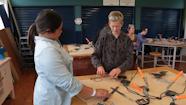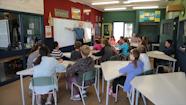Moira Patterson explains technological systems and shares examples to inspire.
Talking about technological systems in primary
Transcript
Moira Patterson: I’ve had very interesting experiences working with teachers, talking about technological systems, lots of discussion around the definition of what a technological system is, how they operate the different inputs and outputs of technological systems. It’s been really revealing to have those discussions.
I think the most defining aspect of the technological system is that once you switch it on it works independently on its own without any further human input, so it works automatically by itself. I think what differentiates a system from a product is the components that are involved in a technological system, so once you switch it on there’s another component that works independently before it produces the output. Now it can actually just be one component that produces an outcome but there can also be a whole intricate array of different components within a technological system that produce an output. So, for example, the difference between a wooden spoon and stirring it in a bowl and an egg beater and stirring something in a bowl, is the spoon is just an extension of the hand, but an egg beater has a component that works independently of you driving that, that egg beater, and it’s that one component that defines that it’s a technological system.
There’s sort of two ways of looking at inputs into a system and this has probably caused a little bit of confusion in the way that teachers and students understand what an input is. Traditionally an input can be talked about as starting a system, when you turn on the lights in the room you switch them on and that’s an input and then the lights work. But there’s also another aspect where the input is actually raw materials, or energy, or information and then that’s transformed by the system into an output. I think today I tend to, instead of using the term input when I switch on the lights, I think about it more as a driver, so what is starting that system, what is driving that system to operate. So, for example, if I’m switching on a light to make an electrical light system work, the driver is the electricity that’s allowing that system to work.
We can also drive systems manually. A good example of that is a bicycle, and when you pedal a bicycle you’re actually enabling it to move, so that’s kinetic energy (as I say, I use the term manual energy) to drive that, that system. That system is still operating independently of you as the user. You’re not down there making the cogs and the chain work together, so it’s working independently and the output is moving forward, but the actual input in that system is the energy to drive that bicycle, but the manual energy is allowing it to be operative.
It’s really important to use actual examples with children because they can explore them, actually the different components within the system. Take, for example, a ball point pen, you can just pull it apart and they can actually see where the starting place is, how it operates with the spring, what's happening to produce an output. Another good example of pulling something apart would be looking at clocks again, you could pull those apart and see the different components that are allowing that system to work.
Another good example of bringing in technological systems is a toaster, and that’s a really great example where you can see the input and output and how that technological system sort of has allowed that output to work. You can put the raw material of bread into the toaster, you operate it, you start it by pushing down the handle and then the output is the actual toast. So bringing in different items for children to explore is really important.
So black boxes are technological systems that we really don’t know how they work on the inside, so a toaster again even though we can see the input and output, we don’t really know much about the elements and how they work. Mobile phones are a good example of a black box – it’s really important that we don’t introduce black boxes too soon, teachers really quite like the idea of black boxes which is really great, but it really doesn’t come in until level three. Then they get the option of exploring them in more detail.
New entrants are really capable of using the language to do with technological systems and I’ve seen a class of five year olds making torches and they’ve been able to describe the input and the components of their torches and the output and they’re very proud of their torches.
Related videos
Planning for a coherent programme in primary (02:11)
Science and technology teacher Shannon Maloney shares how she works collaboratively with teachers to integrate technology into their programmes....
Building technology inquiries in years 1–6 (02:47)
Shannon Maloney talks about building rich technology units within a programme of inquiry in years 1–6.
My role as a lead teacher technology at Green Bay Primary (02:48)
Diana Comp shares about providing resourcing, inspiration, and professional learning in her role as lead teacher technology.
Hooking primary students into technology (02:34)
Diana Comp shares some of her strategies for engaging primary students and growing understandings in technology.
Planning for technology at primary (03:59)
Jude Black and Diana Comp describe their approach to planning at Green Bay Primary.
A school-wide vision for technology teaching and spaces (03:53)
Jude Black of Green Bay Primary prompts us to consider how technology is incorporated into our school vision.
A principal supports technology local curriculum implementation at primary (03:02)
Jude Black describes how her sabbatical changed her thinking and leadership style and inspired her to share her knowledge....
Technology and science work well together (04:39)
Steve Jeffares and Ronnie McHale share how their students deepen conceptual understandings through integrating multiple knowledge bases.
A broad technology programme for year 7–8 (02:00)
Steve Jeffares and Brenda Whycherley inspire confidence in their students by offering a broad programme.
High expectations in years 7–8 technology (03:57)
Steve Jeffares shares how he inspires students to develop a love of learning.


